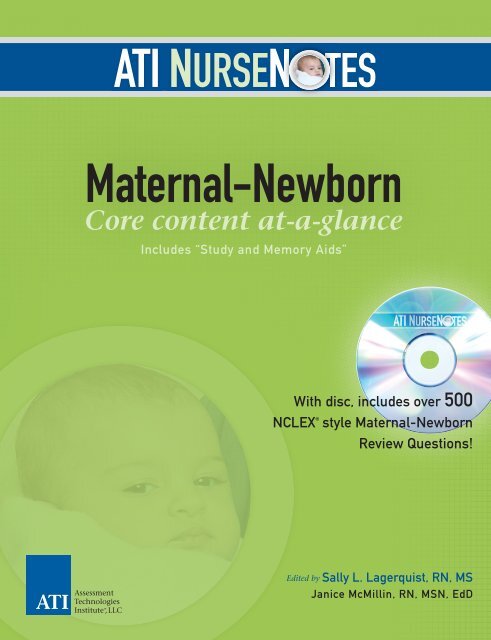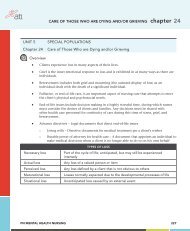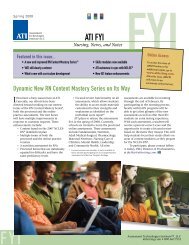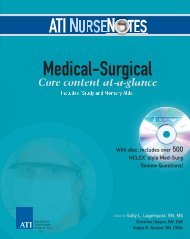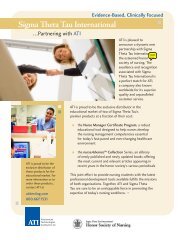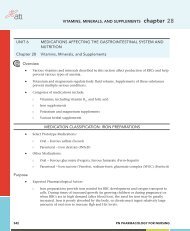Maternal - Newborn - ATI Testing
Maternal - Newborn - ATI Testing
Maternal - Newborn - ATI Testing
You also want an ePaper? Increase the reach of your titles
YUMPU automatically turns print PDFs into web optimized ePapers that Google loves.
<strong>ATI</strong> NURSEN N TES<br />
<strong>Maternal</strong> - <strong>Newborn</strong><br />
Core content at-a-glance<br />
Includes “Study and Memory Aids”<br />
With disc, includes over 500<br />
NCLEX ® style <strong>Maternal</strong>-<strong>Newborn</strong><br />
Review Questions!<br />
Edited by Sally L. Lagerquist, RN, MS<br />
Janice McMillin, RN, MSN, EdD
iii<br />
NurseNotes<br />
<strong>Maternal</strong>–<strong>Newborn</strong><br />
Core Content At-A-Glance<br />
Edited by:<br />
Sally Lambert Lagerquist, RN, MS<br />
Former Instructor in Undergraduate and Graduate Programs<br />
and Continuing Education in Nursing<br />
University of California, San Francisco, School of Nursing<br />
President, Review for Nurses, Inc., and RN Tapes Company<br />
San Francisco, California<br />
Author:<br />
Janice McMillin, BSN, MSN, EdD<br />
Instructor of <strong>Maternal</strong>–Child Nursing at CSU, Sacramento<br />
Clinical Coordinator of Family Birth Center,<br />
Methodist Hospital of Sacramento, California
xvii<br />
Contents<br />
Dedications<br />
Acknowledgements<br />
Foreword<br />
Preface<br />
How to Use the <strong>ATI</strong> NurseNotes Series<br />
List of Illustrations<br />
List of Tables/Pharmacology Boxes<br />
vii<br />
ix<br />
xi<br />
xiii<br />
xv<br />
xix<br />
xxi<br />
1. Growth and Development 1<br />
2. Normal Pregnancy 23<br />
3. High-Risk Conditions and Complications During Pregnancy 49<br />
4. The Intrapartal Experience 95<br />
5. Complications During the Intrapartal Period 127<br />
6. The Postpartal Period 143<br />
7. Complications During the Postpartal Period 159<br />
8. The <strong>Newborn</strong> Infant 173<br />
9. Complications During the Neonatal Period: The High-Risk <strong>Newborn</strong> 191<br />
Glossary 211<br />
Appendixes<br />
A. Common Acronyms and Abbreviations 243<br />
B. Quick Guide to Common Clinical Signs 247<br />
C. Index to: Common Diagnostic Tests and Procedures 249<br />
D. Index to: <strong>Maternal</strong>-<strong>Newborn</strong> Emergencies 251<br />
E. Index to: Diets 253<br />
F. Index to: Positioning the Client 255<br />
G. Index to: Nursing Treatments<br />
(Essential “Hands-On” Care, Skills, Activities and Nursing Procedures) 257<br />
H. Index to: Memory Aids (Mnemonics and Acronyms) 259<br />
I. NANDA-Approved Nursing Diagnoses (with modifications) 261<br />
J. NCLEX-RN Test Plan: Nursing Process/Cognitive Level:<br />
Definitions/Descriptions 263<br />
K. Index to: Questions Related to Nursing Process/Cognitive Level 267<br />
L. Index to: Definitions and Questions Related to Categories of Human Functions 271<br />
M. Index to: Definitions and Questions Related to Client Needs/Client Subneeds 273<br />
N. Resources 277<br />
O. Cervical Dilatation and Gestation Wheel 283<br />
Bibliography 285<br />
Index 287
Study and Memory Aids<br />
83<br />
IV. Evaluation of phospholipids (PG and PI); aids in<br />
determining lung maturity; new and accurate.<br />
V. Determination of creatinine levels, aids in<br />
determining fetal age. (Greater than 1.8 mg/dL<br />
indicates fetal maturity and the fetal age.)<br />
VI. Assessment of isoimmune disease.<br />
VII. Assessment of alpha-fetoprotein (AFP) levels for<br />
determination of neural tube defects.<br />
VIII. Presence of meconium may indicate fetal hypoxia.<br />
Chorionic Villous Sampling (CVS)<br />
I. Cervically invasive procedure.<br />
II. Advantage—results can be obtained after 10 wk<br />
gestation due to fast-growing fetal cells.<br />
III. Procedure—removal of small piece of tissue<br />
(chorionic villi) from fetal portion of placenta.<br />
Tissue reflects genetic makeup of fetus.<br />
IV. Determines some genetic aberrations and allows for<br />
earlier decision for induced abortion (if desired) from<br />
abnormal results. Does not diagnose neural tube<br />
defects; Further diagnoses needed with ultrasound<br />
and serum AFP levels.<br />
V. Protects “pregnancy privacy” because results can<br />
be obtained before the pregnancy is apparent<br />
and decisions can be made regarding abortion or<br />
continuation of gestation.<br />
VI. Risks involve: spontaneous abortion, infection,<br />
hematoma, intrauterine death.<br />
Summary<br />
Assessment for risk factors helps to identify the<br />
population that would benefit from timely intervention.<br />
Early identification is essential in order to plan and<br />
implement management of care throughout the<br />
childbearing cycle.<br />
This chapter focuses on diseases that may predate the<br />
pregnancy: cardiac disease, Rh incompatibility, diabetes,<br />
substance abuse, STDs, age-related factors, cancer,<br />
violence, and other medical-surgical conditions.<br />
In addition, pregnancy-related conditions are discussed:<br />
hemorrhagic disorders; metabolic disorders;<br />
pre-eclampsia, eclampsia, and HELLP syndrome;<br />
and hydramnios.<br />
Diagnostic tests to evaluate fetal growth and well-being<br />
are outlined.<br />
Study and Memory Aids<br />
Insulin Requirements in Pregnancy<br />
↓<br />
Trimester one:<br />
Trimester two:<br />
Trimester three: ↑<br />
Postpartum:<br />
↓<br />
Gestational Diabetes—Assessment: “3 P’s”<br />
Polydipsia<br />
Polyphagia<br />
Polyuria<br />
Heart Failure—Assessment<br />
Heart rate is the most sensitive and reliable indicator of<br />
impending heart failure.<br />
RHoGAM<br />
RhoGam is given to Rh-negative woman only!<br />
Indications for RHoGAM—Give RhoGAM to:<br />
1. Rh- mother who gives birth to Rh+ neonate.<br />
2. Rh- mother after spontaneous or induced abortion<br />
(> 8 wk).<br />
3. Rh- mother after amniocentesis or chorionic villous<br />
sampling (CVS).<br />
4. Rh- mother between 28 and 32 wk gestation.<br />
RhoGAM and Rubella Titer<br />
Since RhoGAM is an immune globulin, rubella<br />
vaccination, given at about the same time, may not<br />
“take”; rubella titer needs to be redone at 3 mo.<br />
Fetal Maturity— Assessment<br />
Phosphatidyl glycerol is more accurate indicator of fetal<br />
lung maturity in women who are diabetic.<br />
Infections<br />
• Vaginitis: avoid douching during pregnancy.<br />
• STDs in the U.S.: highest prevalence among teens.<br />
• AIDS in the U.S.: fourth leading cause of death among<br />
women of reproductive age.<br />
TORCH Infections<br />
Toxoplasmosis<br />
Other (hepatitis A virus [HAV], hepatitis B virus [HBV],<br />
group B streptococcus [GBS])<br />
Rubella<br />
Cytomegalovirus (CMV)<br />
Herpes type 2<br />
Asthma<br />
Avoid morphine for woman with asthma who is in<br />
labor.
84 Chapter 3. High-Risk Conditions and Complications During Pregnancy<br />
Cancer<br />
Malignant melanoma: the only cancer that crosses the<br />
placenta to the fetus.<br />
Cycle of Violence<br />
Phase 1—building: increased tension, anger, blaming, and<br />
arguing<br />
Phase 2—battering: hitting, slapping, kicking, choking, use<br />
of objects or weapons; sexual abuse; verbal threats and<br />
abuse<br />
Phase 3—calm state (may decrease over time): batterer may<br />
deny violence, state he was drunk, say he’s sorry, and<br />
“promise it will never happen again,” returns to<br />
phase 1.<br />
Modified from A Helton. A Protocol of Care for the Battered Woman.White Plains,<br />
NY: March of Dimes Birth Defects Foundation.<br />
Hydatidiform Mole<br />
Complete H. mole: only condition that can lead to<br />
maternal cancer.<br />
Pre-eclampsia<br />
• Proteinuria differentiates pre-eclampsia from other<br />
pregnancy-induced hypertension (PIH) states.<br />
• Pre-eclampsia is a disorder of hypovolemia.<br />
• Home care may eliminate the need for hospitalization<br />
for “mild” pre-eclampsia.<br />
Pre-eclampsia—Diet<br />
Do not eliminate sodium from the diet.<br />
Hypertension—Standard American College of<br />
Obstetricians and Gynecologists (ACOG) Definition<br />
Systolic: 30+ mm Hg above baseline<br />
Diastolic: 15+ mm Hg above baseline<br />
HELLP Syndrome—Assessment<br />
Hemolysis<br />
Elevated Liver (enzymes)<br />
Low Platelets<br />
HELLP Syndrome—Complication<br />
Hypoglycemia: ≤ 40 mg/dL<br />
Hypoglycemia can lead to maternal mortality..<br />
Placenta Previa<br />
Vaginal examinations contraindicated with undiagnosed<br />
vaginal bleeding.<br />
Questions<br />
1. The nurse is planning to lead a seminar for young<br />
adults on violence against women, concentrating<br />
on abuse of women who are pregnant. Which<br />
statement is accurate and would be part of the<br />
nurse’s discussion?<br />
1. Most of these women live below poverty level.<br />
2. Alcohol has been causally related to battering.<br />
3. The prevalence of violence lessens during<br />
pregnancy, dropping to a range of 2–4%.<br />
4. Women who are abused are more likely to<br />
have infants who are low-birth-weight (LBW)<br />
infants than women who are not abused during<br />
pregnancy.<br />
2. The mode of birth of children with mothers who<br />
are HIV+ follows obstetric indications. Which is an<br />
unnecessary precaution for this client?<br />
1. Avoid scalp electrodes for electronic fetal<br />
monitoring.<br />
2. Avoid scalp pH determinations.<br />
3. Remove newborn to special care nursery<br />
immediately after birth.<br />
4. Delay amniotomy to reduce possibility of vertical<br />
transmission of HIV.<br />
3. A nurse is discussing sexually transmitted diseases<br />
with a class of high school seniors. The students<br />
submitted a list of what they knew. The nurse<br />
evaluated the list. The only accurate statement is<br />
that gonorrhea:<br />
1. Is often spread through fomites.<br />
2. Is only spread through promiscuous sex.<br />
3. Is easily cured with penicillin.<br />
4. Can be prevented if condoms are used for sexual<br />
encounters.<br />
4. The nurse considers a blood pressure of 120/80<br />
in a woman who is pregnant as indicative of preeclampsia<br />
if:<br />
1. The woman has gained 2 pounds for each of the<br />
previous 2 wks.<br />
2. The woman is carrying a hydatidiform mole.<br />
3. The woman has had ankle edema each evening<br />
for the previous 2 wks.<br />
4. The woman’s systolic pressure has increased by<br />
30 mm Hg; the diastolic by 15 mm Hg.<br />
5. A nurse case manager is developing a plan of care<br />
for a woman who is 4 wk pregnant with a Class I<br />
functional classification of organic heart disease. The<br />
nurse knows to plan for what normal adaptation<br />
to pregnancy that can place a client with cardiac<br />
disease at risk?<br />
1. Physiologic anemia.<br />
2. Increase in cardiac output after the 34th week.<br />
3. Gradual increase in size and weight of the uterus.<br />
4. Increased heart rate during the last half of<br />
pregnancy.


